Evolution and Darwin's Theory: Biological Traits and Inheritance
VerifiedAdded on 2022/11/16
|5
|961
|375
Essay
AI Summary
This essay provides an overview of Darwin's theory of evolution, emphasizing the concept of natural selection and its role in the change of species over time. It discusses the supportive evidence from various scientific disciplines, including genetics, geology, and paleontology, which substantiate evolution as a well-established scientific theory. The essay then delves into Darwin's theory that all living species are related and derived from a common ancestor, highlighting how natural selection preserves beneficial genetic mutations. It explores the role of genetics in modern science, explaining how genes control inherited traits and influence phenotypic variations, while also touching upon the complexities of social stratification and how biological traits should not be the sole basis for societal distinctions. Finally, it examines how traits are inherited from parents and the impact of genetic variations on evolution.
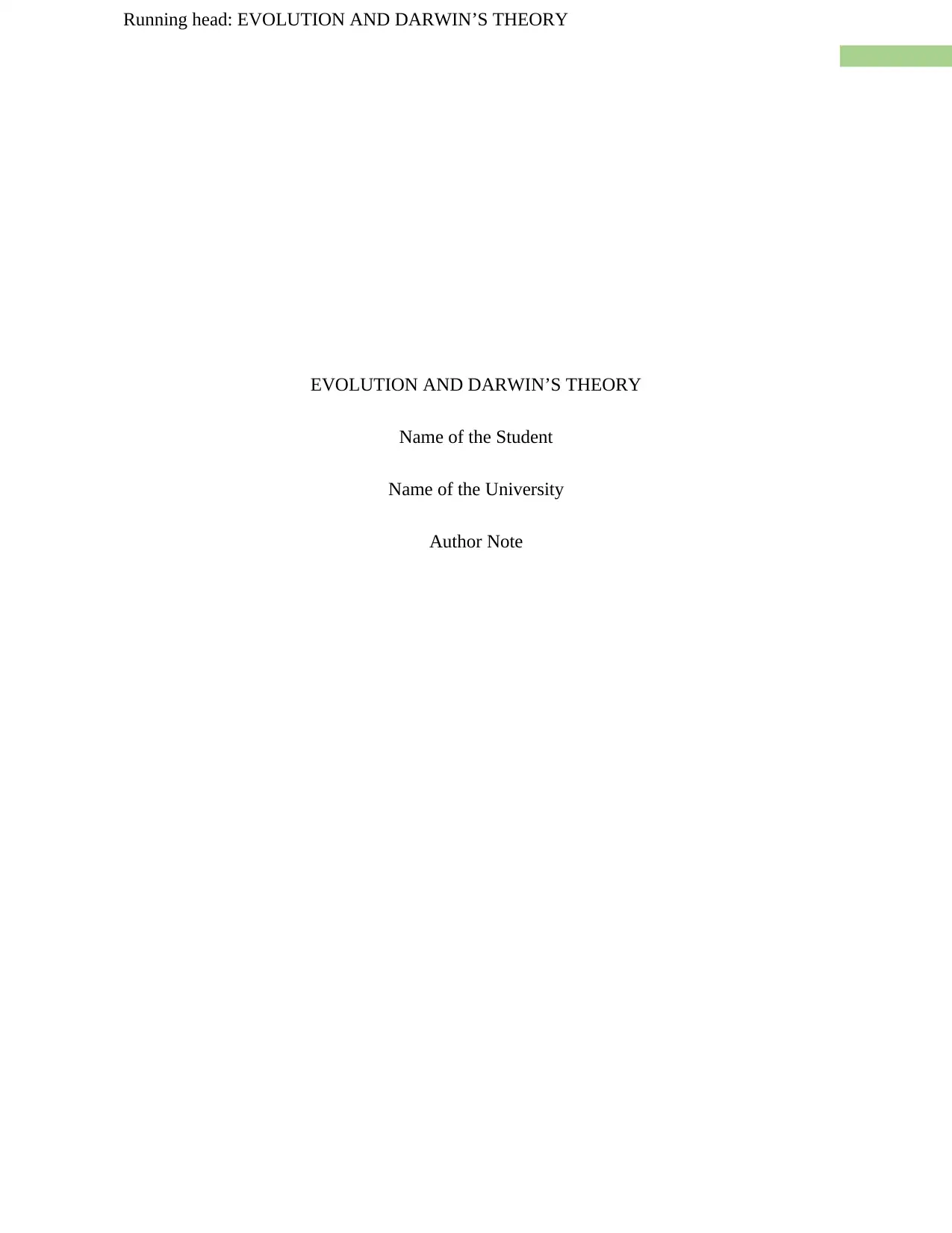
Running head: EVOLUTION AND DARWIN’S THEORY
EVOLUTION AND DARWIN’S THEORY
Name of the Student
Name of the University
Author Note
EVOLUTION AND DARWIN’S THEORY
Name of the Student
Name of the University
Author Note
Paraphrase This Document
Need a fresh take? Get an instant paraphrase of this document with our AI Paraphraser
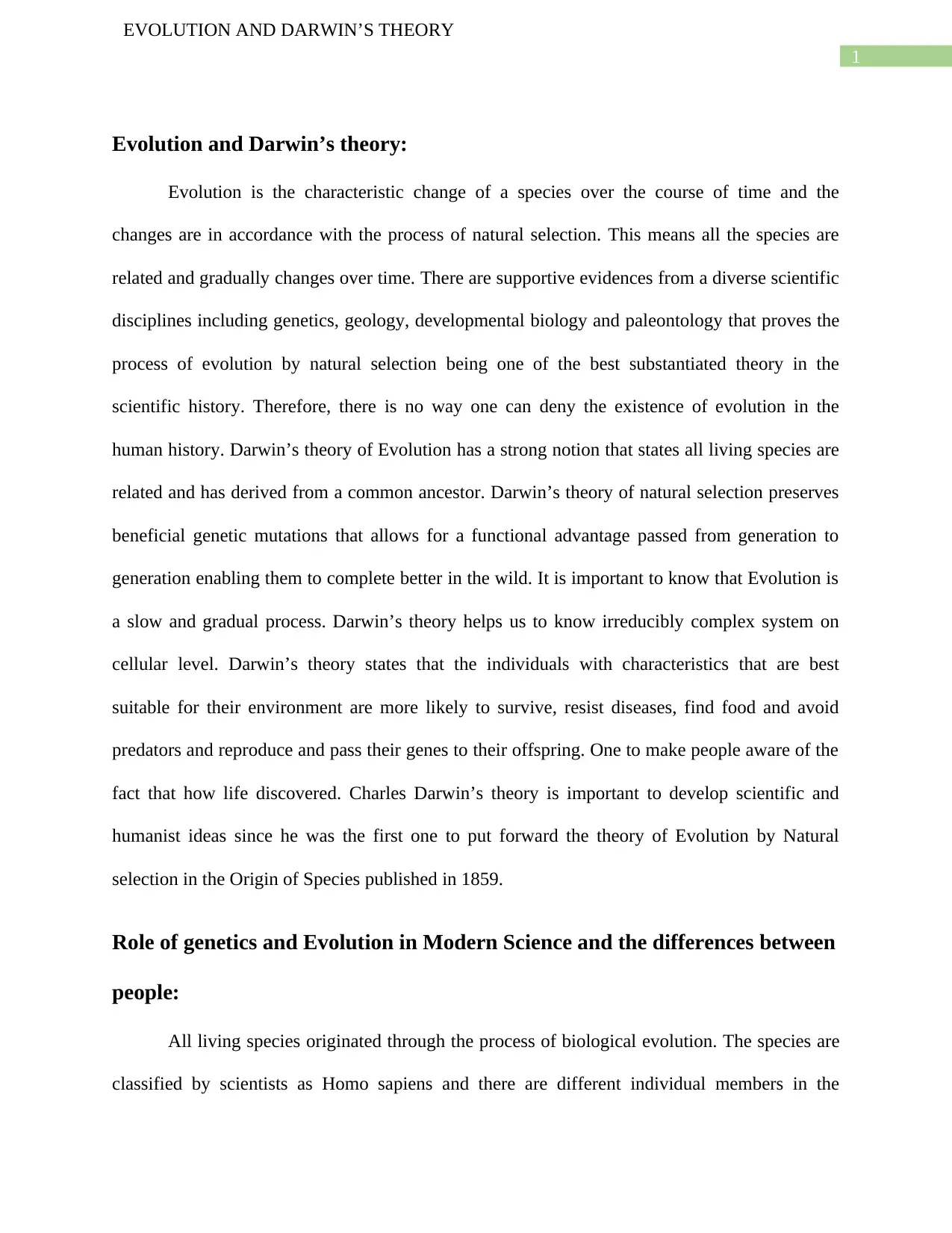
1
EVOLUTION AND DARWIN’S THEORY
Evolution and Darwin’s theory:
Evolution is the characteristic change of a species over the course of time and the
changes are in accordance with the process of natural selection. This means all the species are
related and gradually changes over time. There are supportive evidences from a diverse scientific
disciplines including genetics, geology, developmental biology and paleontology that proves the
process of evolution by natural selection being one of the best substantiated theory in the
scientific history. Therefore, there is no way one can deny the existence of evolution in the
human history. Darwin’s theory of Evolution has a strong notion that states all living species are
related and has derived from a common ancestor. Darwin’s theory of natural selection preserves
beneficial genetic mutations that allows for a functional advantage passed from generation to
generation enabling them to complete better in the wild. It is important to know that Evolution is
a slow and gradual process. Darwin’s theory helps us to know irreducibly complex system on
cellular level. Darwin’s theory states that the individuals with characteristics that are best
suitable for their environment are more likely to survive, resist diseases, find food and avoid
predators and reproduce and pass their genes to their offspring. One to make people aware of the
fact that how life discovered. Charles Darwin’s theory is important to develop scientific and
humanist ideas since he was the first one to put forward the theory of Evolution by Natural
selection in the Origin of Species published in 1859.
Role of genetics and Evolution in Modern Science and the differences between
people:
All living species originated through the process of biological evolution. The species are
classified by scientists as Homo sapiens and there are different individual members in the
EVOLUTION AND DARWIN’S THEORY
Evolution and Darwin’s theory:
Evolution is the characteristic change of a species over the course of time and the
changes are in accordance with the process of natural selection. This means all the species are
related and gradually changes over time. There are supportive evidences from a diverse scientific
disciplines including genetics, geology, developmental biology and paleontology that proves the
process of evolution by natural selection being one of the best substantiated theory in the
scientific history. Therefore, there is no way one can deny the existence of evolution in the
human history. Darwin’s theory of Evolution has a strong notion that states all living species are
related and has derived from a common ancestor. Darwin’s theory of natural selection preserves
beneficial genetic mutations that allows for a functional advantage passed from generation to
generation enabling them to complete better in the wild. It is important to know that Evolution is
a slow and gradual process. Darwin’s theory helps us to know irreducibly complex system on
cellular level. Darwin’s theory states that the individuals with characteristics that are best
suitable for their environment are more likely to survive, resist diseases, find food and avoid
predators and reproduce and pass their genes to their offspring. One to make people aware of the
fact that how life discovered. Charles Darwin’s theory is important to develop scientific and
humanist ideas since he was the first one to put forward the theory of Evolution by Natural
selection in the Origin of Species published in 1859.
Role of genetics and Evolution in Modern Science and the differences between
people:
All living species originated through the process of biological evolution. The species are
classified by scientists as Homo sapiens and there are different individual members in the
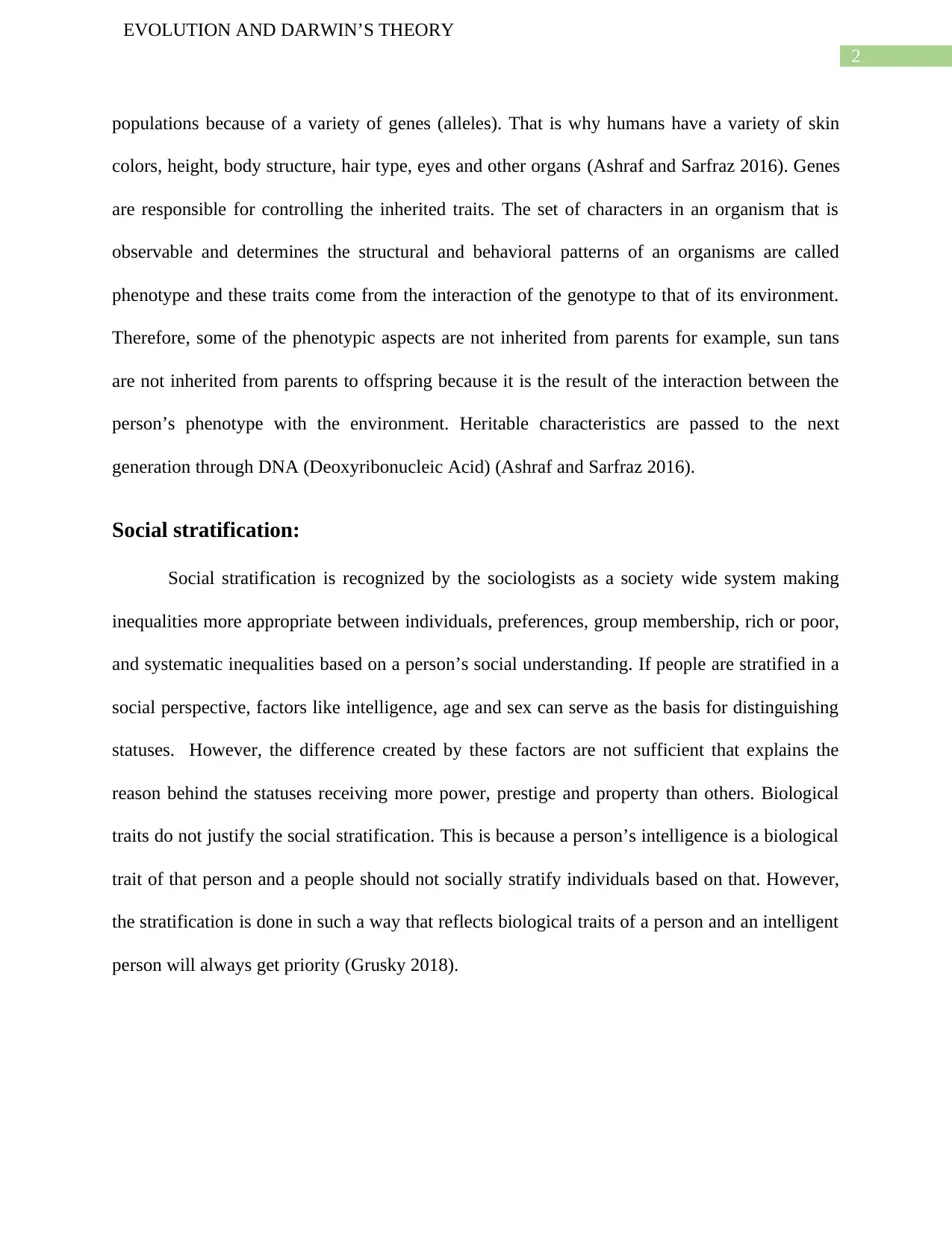
2
EVOLUTION AND DARWIN’S THEORY
populations because of a variety of genes (alleles). That is why humans have a variety of skin
colors, height, body structure, hair type, eyes and other organs (Ashraf and Sarfraz 2016). Genes
are responsible for controlling the inherited traits. The set of characters in an organism that is
observable and determines the structural and behavioral patterns of an organisms are called
phenotype and these traits come from the interaction of the genotype to that of its environment.
Therefore, some of the phenotypic aspects are not inherited from parents for example, sun tans
are not inherited from parents to offspring because it is the result of the interaction between the
person’s phenotype with the environment. Heritable characteristics are passed to the next
generation through DNA (Deoxyribonucleic Acid) (Ashraf and Sarfraz 2016).
Social stratification:
Social stratification is recognized by the sociologists as a society wide system making
inequalities more appropriate between individuals, preferences, group membership, rich or poor,
and systematic inequalities based on a person’s social understanding. If people are stratified in a
social perspective, factors like intelligence, age and sex can serve as the basis for distinguishing
statuses. However, the difference created by these factors are not sufficient that explains the
reason behind the statuses receiving more power, prestige and property than others. Biological
traits do not justify the social stratification. This is because a person’s intelligence is a biological
trait of that person and a people should not socially stratify individuals based on that. However,
the stratification is done in such a way that reflects biological traits of a person and an intelligent
person will always get priority (Grusky 2018).
EVOLUTION AND DARWIN’S THEORY
populations because of a variety of genes (alleles). That is why humans have a variety of skin
colors, height, body structure, hair type, eyes and other organs (Ashraf and Sarfraz 2016). Genes
are responsible for controlling the inherited traits. The set of characters in an organism that is
observable and determines the structural and behavioral patterns of an organisms are called
phenotype and these traits come from the interaction of the genotype to that of its environment.
Therefore, some of the phenotypic aspects are not inherited from parents for example, sun tans
are not inherited from parents to offspring because it is the result of the interaction between the
person’s phenotype with the environment. Heritable characteristics are passed to the next
generation through DNA (Deoxyribonucleic Acid) (Ashraf and Sarfraz 2016).
Social stratification:
Social stratification is recognized by the sociologists as a society wide system making
inequalities more appropriate between individuals, preferences, group membership, rich or poor,
and systematic inequalities based on a person’s social understanding. If people are stratified in a
social perspective, factors like intelligence, age and sex can serve as the basis for distinguishing
statuses. However, the difference created by these factors are not sufficient that explains the
reason behind the statuses receiving more power, prestige and property than others. Biological
traits do not justify the social stratification. This is because a person’s intelligence is a biological
trait of that person and a people should not socially stratify individuals based on that. However,
the stratification is done in such a way that reflects biological traits of a person and an intelligent
person will always get priority (Grusky 2018).
⊘ This is a preview!⊘
Do you want full access?
Subscribe today to unlock all pages.

Trusted by 1+ million students worldwide
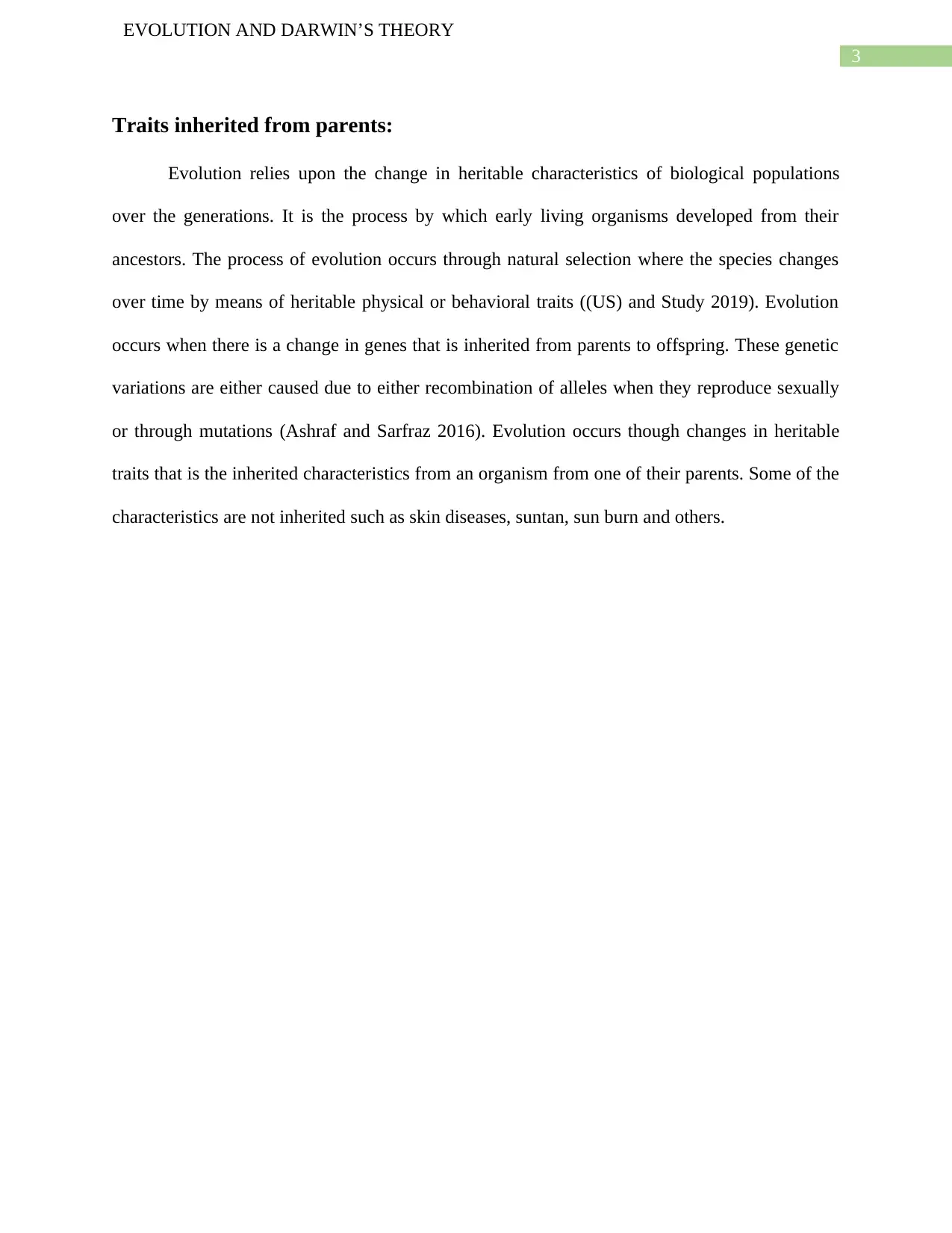
3
EVOLUTION AND DARWIN’S THEORY
Traits inherited from parents:
Evolution relies upon the change in heritable characteristics of biological populations
over the generations. It is the process by which early living organisms developed from their
ancestors. The process of evolution occurs through natural selection where the species changes
over time by means of heritable physical or behavioral traits ((US) and Study 2019). Evolution
occurs when there is a change in genes that is inherited from parents to offspring. These genetic
variations are either caused due to either recombination of alleles when they reproduce sexually
or through mutations (Ashraf and Sarfraz 2016). Evolution occurs though changes in heritable
traits that is the inherited characteristics from an organism from one of their parents. Some of the
characteristics are not inherited such as skin diseases, suntan, sun burn and others.
EVOLUTION AND DARWIN’S THEORY
Traits inherited from parents:
Evolution relies upon the change in heritable characteristics of biological populations
over the generations. It is the process by which early living organisms developed from their
ancestors. The process of evolution occurs through natural selection where the species changes
over time by means of heritable physical or behavioral traits ((US) and Study 2019). Evolution
occurs when there is a change in genes that is inherited from parents to offspring. These genetic
variations are either caused due to either recombination of alleles when they reproduce sexually
or through mutations (Ashraf and Sarfraz 2016). Evolution occurs though changes in heritable
traits that is the inherited characteristics from an organism from one of their parents. Some of the
characteristics are not inherited such as skin diseases, suntan, sun burn and others.
Paraphrase This Document
Need a fresh take? Get an instant paraphrase of this document with our AI Paraphraser
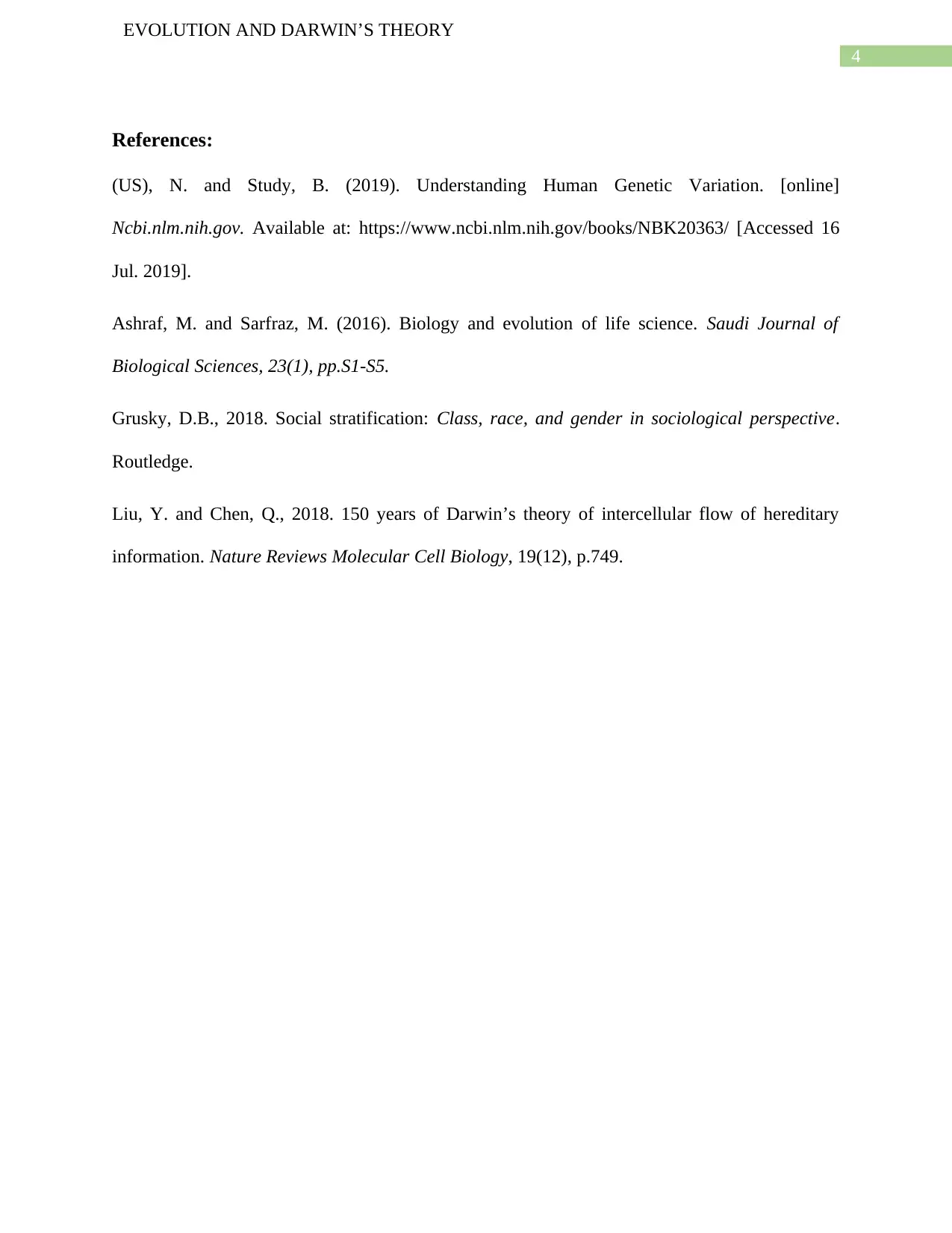
4
EVOLUTION AND DARWIN’S THEORY
References:
(US), N. and Study, B. (2019). Understanding Human Genetic Variation. [online]
Ncbi.nlm.nih.gov. Available at: https://www.ncbi.nlm.nih.gov/books/NBK20363/ [Accessed 16
Jul. 2019].
Ashraf, M. and Sarfraz, M. (2016). Biology and evolution of life science. Saudi Journal of
Biological Sciences, 23(1), pp.S1-S5.
Grusky, D.B., 2018. Social stratification: Class, race, and gender in sociological perspective.
Routledge.
Liu, Y. and Chen, Q., 2018. 150 years of Darwin’s theory of intercellular flow of hereditary
information. Nature Reviews Molecular Cell Biology, 19(12), p.749.
EVOLUTION AND DARWIN’S THEORY
References:
(US), N. and Study, B. (2019). Understanding Human Genetic Variation. [online]
Ncbi.nlm.nih.gov. Available at: https://www.ncbi.nlm.nih.gov/books/NBK20363/ [Accessed 16
Jul. 2019].
Ashraf, M. and Sarfraz, M. (2016). Biology and evolution of life science. Saudi Journal of
Biological Sciences, 23(1), pp.S1-S5.
Grusky, D.B., 2018. Social stratification: Class, race, and gender in sociological perspective.
Routledge.
Liu, Y. and Chen, Q., 2018. 150 years of Darwin’s theory of intercellular flow of hereditary
information. Nature Reviews Molecular Cell Biology, 19(12), p.749.
1 out of 5
Related Documents
Your All-in-One AI-Powered Toolkit for Academic Success.
+13062052269
info@desklib.com
Available 24*7 on WhatsApp / Email
![[object Object]](/_next/static/media/star-bottom.7253800d.svg)
Unlock your academic potential
Copyright © 2020–2025 A2Z Services. All Rights Reserved. Developed and managed by ZUCOL.





